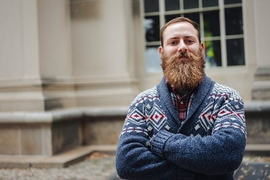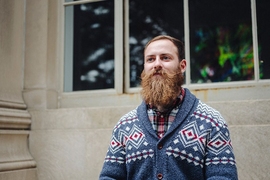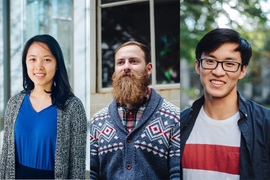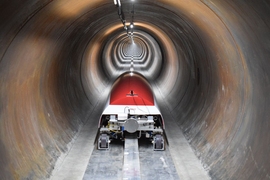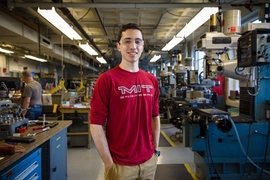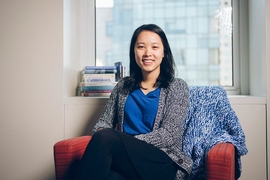Nick Schwartz likes to describe himself as “a nerd with a heart.” Before finals period at the end of each fall semester, the mechanical engineering senior and nuclear fusion enthusiast dons a Santa Claus costume and hands out candy to students, staff, and faculty passing through the lobby of Building 7.
“I came up with [the idea] my sophomore year and thought it would be really fun,” Schwartz says. For his senior year, Schwartz aimed for something “bigger than ever.” He and his elves — his friends and classmates who also join in on the holiday costume-wearing — handed out thousands of pieces of candy while Christmas music played in the background.
“It makes a lot of people smile,” he says proudly of his annual tradition, which is funded by the MIT SHASS-based de Florez Fund for Humor. Schwartz tends to make a lot of people smile with his work — both inside and outside of MIT.
Meaningful engineering
When Schwartz first arrived at the Institute, he wasn’t committed to engineering until he took 2.001 (Mechanics and Materials I), with Rohan Abeyaratne, the Quentin Berg Professor of Mechanics, during his freshman spring semester.
“It was fascinating because we were learning these very complicated theories, and then every single class we were applying them to real problems,” Schwartz says. “What I love about mechanical engineering is that you create things that you can hold and build yourself, if you have the tools to do so.”
As his studies have progressed, he has focused on two specific areas: engineering for the developing world, and nuclear fusion. During his sophomore year, Schwartz worked on prosthetic devices in the MIT D-Lab and field-tested in Kenya and Ethiopia a pediatric transtibial prosthetic liner he designed.
Schwartz also worked on the MIT Hyperloop Team during his sophomore and junior years, to help design a concept pod for the SpaceX Hyperloop Pod Competition.
“I was one of the two or three undergraduates on this team, and, because I was surrounded by insanely smart graduate students, I was able to learn so much about the theoretical aspects of design as well as machining, and how to combine those two,” Schwartz says. In January 2017, the team won the Safety and Reliability Award and placed third overall.
Though Schwartz enjoyed participating in the team, he began to think even more broadly and wondered, “What is something unbelievably attractive in terms of engineering and has the possibility to change the world if it’s successful?”
His answer? Nuclear fusion. “I truly believe that it has the ability to flip the energy industry on its head completely,” he says.
Unlike nuclear fission, which involves splitting a uranium-235 atom to generate traditional nuclear power, fusion involves the combination of two atoms, which has the potential to generate much more energy than fission. The process requires extremely high temperatures and careful control: An example of where fusion currently occurs is the sun.
Changing lives for the better
With nuclear fusion research, Schwartz is pursuing his ideal kind of engineering. “The kind of engineering that I want to do is the kind that can change people’s lives for the better,” Schwartz says. “Not many people think of this massive nuclear fusion reactor as doing that. But, if this system is as successful as I think it can be, then the 2 million people in India or the 40,000 in the United Kingdom who could die each year because of air pollution won’t have to anymore.”
To get started with research, Schwartz reached out to nuclear fusion companies and asked to work with them. One of those companies responded: Tri Alpha Energy. Schwartz worked as a mechanical design intern at the company the summer before his senior year.
“I got to experience a lot of really complicated technical challenges there,” Schwartz says. “Also, everybody at the company cared so much about the outcome of what [nuclear fusion] could do. I thought it was awesome.”
The experience left Schwartz with a strong sense of determination: “I know that to be as effective as possible in terms of getting fusion to the top of the list for renewables and replacing fossil fuels, I need to have a technical background.” Next semester, Schwartz will perform thesis research at MIT’s Plasma Science and Fusion Center. After graduating, he will study physics with extended research at Imperial College London as a 2018 Marshall Scholar. After, he plans to pursue a PhD.
Resilience and forward thinking
Part of Schwartz’s confidence to pursue his goals comes from the encouragement of MIT professors and staff, starting with Abeyaratne from 2.001.
“I like to say that [Abeyaratne] was the first person I met at MIT who believed in my hopes and aspirations. It is fantastic to have a mentor like him,” Schwartz says. “I would go into his office hours for his class all the time because [his class] was really hard. … And then after the class, we would just talk about our lives.” Likewise, Schwartz appreciates the mentorship he’s received from lecturer Jeffrey Moran, who taught 2.006 (Thermal-Fluids Engineering II), which Schwartz remembers as “arguably the hardest class I’ve ever taken, and [Moran] made it all so clear.”
Schwartz also credits Kimberly Benard, assistant dean for distinguished fellowships: “She’s been so instrumental in helping me realize what my true hopes and aspirations even are. She’s another person who truly believes in me.”
But, Schwartz’s biggest source of inspiration is the children who gather each summer to attend Camp Kesem, a camp for children whose parents have been affected by cancer. Since his freshman year, Schwartz has worked at the camp each summer as a counselor, along with other MIT students.
“Without a doubt, it’s been the most meaningful experience of my life and the one thing that I’ve ever done that I’m most proud of,” Schwartz says. “It’s this incredible opportunity to give back to the people who need it most.”
“The strongest people I’ve ever met are my 6- and 7-year-old campers,” he continues. “It’s pretty admirable what they have to deal with and how resilient they are.”
Schwartz spoke about his experiences at Camp Kesem in a November 2017 TEDx talk titled, “Love Gives Resiliency.” At the talk, Schwartz remembers, the audience was filled with Camp Kesem campers, parents, and staff: “It was inspiring.”
His campers affectionately refer to Schwartz by his camp name, Taz. Another feature has garnered their attention: his beard.
Schwartz grew the beard for fun but decided to keep it for good after a conversation with one of his campers. “I asked one of them, ‘What would you do if I came back to camp next year and I shaved?’ And he started bawling.” Schwartz realized then that the beard was here to stay.
Schwartz won’t be letting down his campers, his mentors, or others in his community any time soon: He plans to continue a lifetime of service through his research and activities after he graduates from MIT.
“For the past four years, I have had so many people believe in what I want to do. [This fall], I was walking past the big dome and I was thinking about that, and, for the first time, I actually believed in myself because all these people have chosen to support me,” Schwartz says. “And it was this wonderful feeling of bliss. I worked very hard to get where I am, but I could not have done it without the people who surrounded me. And I think that’s a special feeling that I’m very lucky to have.”
